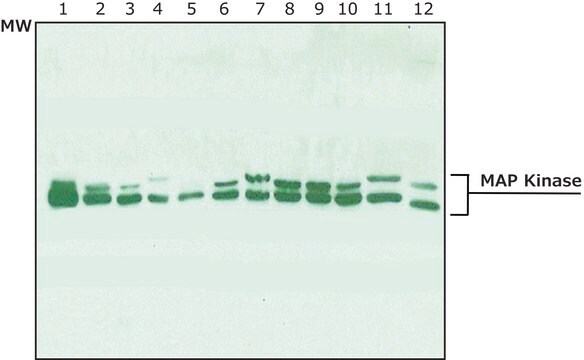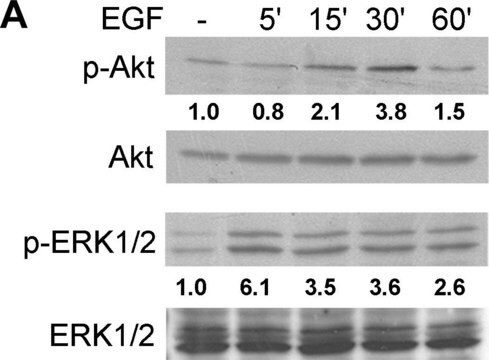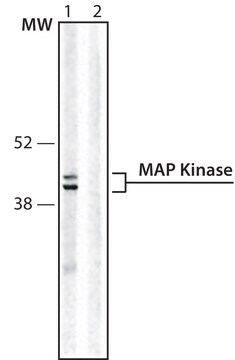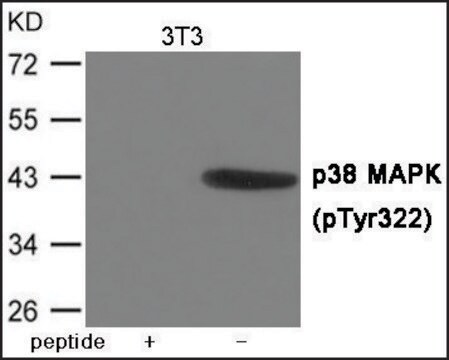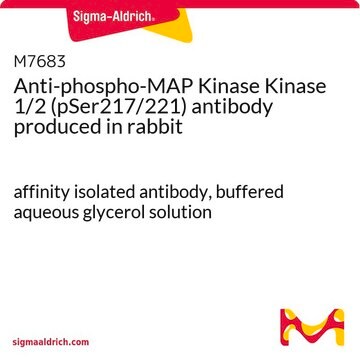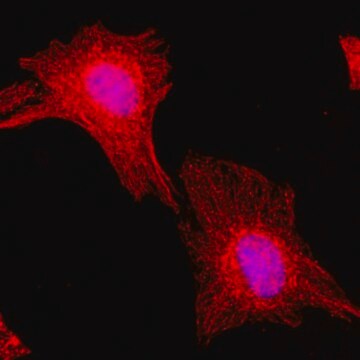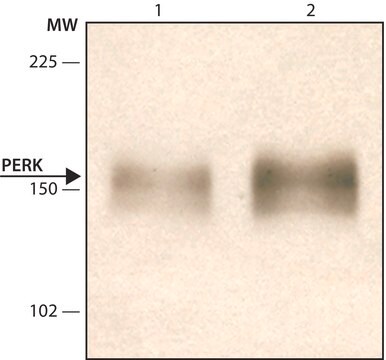M9692
Anti-MAP Kinase, Activated (Diphosphorylated ERK-1&2) antibody, Mouse monoclonal
clone MAPK-YT, purified from hybridoma cell culture
Sinônimo(s):
Monoclonal Anti-MAP Kinase, Activated (Diphosphorylated ERK-1&2)
About This Item
Produtos recomendados
fonte biológica
mouse
Nível de qualidade
conjugado
unconjugated
forma do anticorpo
purified immunoglobulin
tipo de produto de anticorpo
primary antibodies
clone
MAPK-YT, monoclonal
Formulário
buffered aqueous solution
peso molecular
antigen ERK-1 44 kDa
antigen ERK-2 42 kDa
reatividade de espécies
human, Caenorhabditis elegans, Xenopus, Drosophila, hamster, rat, bovine, mouse, yeast
embalagem
antibody small pack of 25 μL
concentração
1.5-2 mg/mL
técnica(s)
immunocytochemistry: suitable
immunohistochemistry (formalin-fixed, paraffin-embedded sections): suitable
immunoprecipitation (IP): suitable
indirect ELISA: suitable
microarray: suitable
western blot: 0.5-1 μg/mL using a whole cell extract of RAT-1 cells treated with vanadate and H2O2.
Isotipo
IgG1
nº de adesão UniProt
Condições de expedição
dry ice
temperatura de armazenamento
−20°C
modificação pós-traducional do alvo
unmodified
Informações sobre genes
human ... MAPK1(5594) , MAPK3(5595)
mouse ... Mapk1(26413) , Mapk3(26417)
rat ... Mapk1(116590) , Mapk3(50689)
Procurando produtos similares? Visita Guia de comparação de produtos
Descrição geral
Anti-MAP Kinase, Activated (Diphosphorylated ERK-1&2) antibody, Mouse monoclonal (mouse IgG1 isotype) is derived from the MAPK-YT hybridoma produced by the fusion of mouse myeloma cells (NS1) and splenocytes from BALB/c mice immunized with a synthetic phosphorylated peptide containing amino acids corresponding to the phosphorylated form of ERK-activation loop, conjugated to KLH. The isotype is determined by a double diffusion immunoassay using Mouse Monoclonal Antibody Isotyping Reagents, Product Number ISO2.
Especificidade
Imunogênio
Aplicação
Monoclonal Anti-MAP Kinase, activated (Diphosphorylated ERK-1&2) antibody produced in mouse has been used in detection of
- ERK1/2 in cardiac myocytes using immunofluorescence microscopy
- ERK1/2 in human eosinophils using western blotting
- ERK in human bronchial epithelial cells using protein array
- ERK proteins in human liver cell lines using immunofluorescence assay and western blot analysis
- ERK1/2 in human embryonic kidney cells by immunoprecipitation
Ações bioquímicas/fisiológicas
Monoclonal Anti-MAP Kinase, Activated (Diphosphorylated ERK-1 and 2) is specific for the active, dually-phosphorylated form of MAP kinase (ERK-1 and ERK-2, 44 kDa and 42 kDa, respectively). The epitope recognized by the antibody contains the phosphorylated threonine and tyrosine residues within the regulatory site of active MAP kinase (Thr183 and Tyr185 in ERK-2). It does not recognize the non-phosphorylated or the monophosphorylated forms of the MAP kinase molecule or the diphosphorylated form of Jun-kinase (JNK) and p38 MAP kinase.
Signaling pathways mediated by MAPK are associated in the pathogenesis of neurodegenerative disorders and cancer. Deletion in the ERK1 gene locus is associated with DiGeorge syndrome (DGS) and velocardiofacial syndrome (VCFS) and congenital heart defects. Rearrangements in MAPK3 gene locus may contribute in the pathogenesis of autism spectrum disorders and schizophrenia.
forma física
Armazenamento e estabilidade
Exoneração de responsabilidade
Não está encontrando o produto certo?
Experimente o nosso Ferramenta de seleção de produtos.
Código de classe de armazenamento
12 - Non Combustible Liquids
Classe de risco de água (WGK)
nwg
Ponto de fulgor (°F)
Not applicable
Ponto de fulgor (°C)
Not applicable
Equipamento de proteção individual
Eyeshields, Gloves, multi-purpose combination respirator cartridge (US)
Escolha uma das versões mais recentes:
Já possui este produto?
Encontre a documentação dos produtos que você adquiriu recentemente na biblioteca de documentos.
Os clientes também visualizaram
Artigos
Alzheimer's disease (AD) is the most common cause of dementia in the elderly and is characterized by gradual loss of cognitive functions.
Nossa equipe de cientistas tem experiência em todas as áreas de pesquisa, incluindo Life Sciences, ciência de materiais, síntese química, cromatografia, química analítica e muitas outras.
Entre em contato com a assistência técnica